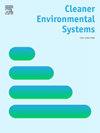新兴木材产品的生命周期评估:交叉层压竹
IF 4.9
Q2 ENGINEERING, ENVIRONMENTAL
引用次数: 0
摘要
竹材复合材料是一种新型的块状木制品,可以替代传统的不可再生建筑材料。本研究进行了从摇篮到坟墓的生命周期评估(LCA),量化了CLB面板在100年内的环境影响。LCA与过程模型模拟相结合,探索不同燃料选择(燃烧竹渣或将竹渣转化为生物炭和燃烧天然气)和寿命终止案例对结果的影响,并结合蒙特卡罗模拟来研究与CLB生命周期阶段相关的不确定性和可变性。结果表明,在1 m3 CLB的基础上,平均生命周期全球变暖潜势(GWP)在−318 ~−947 kg co2当量之间。与利用竹渣生产生物炭和燃烧天然气作为能源供应相比,燃烧生产过程中的竹渣产生的生命周期GWP更低。提高CLB板的回收率可以进一步降低全生命周期的GWP。竹废料的垃圾填埋场腐烂是一个重要的碳排放源,突出了考虑CLB面板寿命终止情况的重要性。在比较各种情景时,各种环境影响类别之间出现了权衡。本文章由计算机程序翻译,如有差异,请以英文原文为准。

Life cycle assessment of emerging mass timber product: Cross-laminated bamboo
Cross-laminated bamboo (CLB) is a new type of mass timber product that can be a substitute for traditional non-renewable construction materials. This study conducted a cradle-to-grave life cycle assessment (LCA) to quantify the environmental impacts of CLB panels over 100 years. The LCA was integrated with process model simulation to explore the effects of varied fuel options (combusting bamboo residues or converting bamboo residues into biochar and combusting natural gas) and end-of-life cases on the results, and coupled with Monte Carlo simulation to investigate the uncertainties and variabilities associated with the CLB life cycle stages. Our results show that, on the 1 m3 CLB basis, the average life-cycle global warming potential (GWP) ranged from −318 to −947 kg CO2eq. Combusting the bamboo residues from production processes resulted in lower life-cycle GWP than utilizing bamboo residues to produce biochar and burning natural gas for energy supply. Increasing the recycling rate of CLB panels can further reduce the life-cycle GWP. The landfill decay of bamboo wastes is a significant carbon emission source, highlighting the importance of considering end-of-life cases for CLB panels. Trade-offs emerge among varied environmental impact categories when the scenarios are compared.
求助全文
通过发布文献求助,成功后即可免费获取论文全文。
去求助
来源期刊

Cleaner Environmental Systems
Environmental Science-Environmental Science (miscellaneous)
CiteScore
7.80
自引率
0.00%
发文量
32
审稿时长
52 days
 求助内容:
求助内容: 应助结果提醒方式:
应助结果提醒方式:


